
Figure 16.1:Comparison between homes with conventional (right) and water-efficient (left) systems.
With global concerns over water shortages, conservation and efficiency have become highly important for governments, designers and homeowners. In response, technologies that minimize water usage, and recycle waste water without compromising quality or service have been developed. Such tools are being put to use to create water-efficient dwellings.
Homeowners stand to save the most water, and as a result money, by implementing several measures indoors where over 70 per cent of domestic use takes place (Environmental Protection Agency 2011). This can be achieved by focusing on increasing appliance efficiency and decreasing flow rates. Conventional toilets, for example, currently account for 27 per cent of total water usage. That figure can be reduced by more than 20 per cent by replacing conventional toilets with more efficient models (Schaeffer 2005, Johnston and Gibson 2008). In fact, using such fixtures can lead to an overall water saving of 35 per cent in an average sized home (American Water Works Association 2010). These technologies can be applied to most fixtures and appliances found in the bathroom and the kitchen.
It is also possible to decrease mains water usage (water treated and supplied by the local authorities) by supplementing it with grey water (waste water from all domestic appliances except toilets) or surface water (rainfall or small bodies of water in the ground) (Johnston and Gibson 2008). There are a variety of systems such as cisterns and grey-water pipes that can be used to collect and distribute these alternative water sources. Despite the fact that some municipalities are hesitant to legislate for their installation due to health concerns, these systems present an opportunity to recycle and reuse water in a safe, clean way and are already widely used.
It is important that designers and homeowners review the latest water-efficient fixtures to see which will best suit their needs and budget. For toilets, there exist four common types: dual flush, high-efficiency, pressure-assisted and composting toilets (Johnston and Gibson 2008). The dual-flush toilet is highly versatile because of its two modes – one for high water conservation and another for a standard flush. The setting allows one to flush with 6 ltr (1.6 gal) per flush, which is still remarkably low compared to the many old 23 ltr (6 gal) per flush toilets that still exist in homes. The ultra-low volume mode on the other hand, can use as little as 3 ltr (0.8 gal) per flush, resulting in potential savings of up to 6057 ltr (1,600 gal) of water per year per household (Johnston and Gibson 2008). It is important to note, however, that since current technologies have produced single-flush high-efficiency toilets, which use less than 4.8 ltr (1.28 gal) per flush for all requirements, the overall advantage of dual flush has diminished and the choice between dual and single is now a matter of preference for the homeowner (CMHC 2010).
Pressure-assisted toilets are able to reach even lower levels of water usage. These toilets function by using a build up of compressed air from the previous flush to create a highvelocity flush that can use as little as 3.8 ltr (1 gal) per flush. Other pressure-assisted models function with compressed water; however, each version is equally effective, so selection is a matter of personal preference (CMHC 2010, Johnston and Gibson 2008).
Lastly, homeowners are able to reduce their water usage even further by using a composting toilet. While this may not be the preferred water-saving method for some, others have found the composting toilet to be a great tool to reduce their water usage as well as to produce fertilizer for local flora. These toilets come in a variety of styles but almost all are based upon the principles of collecting waste in a well-vented chamber without the use of water, and then turning it into compost over a period of a few months. More innovative designs can include fans, aggressive bacteria cultures and heaters to accelerate the composting process (Johnston and Gibson 2008).
In addition to reducing water usage in toilets, homeowners looking to build water-efficient dwellings should consider shower-head technologies. While conventional showers can account for up to 22 per cent of the total indoor water use due to their high flow rates, at 15 to 20 ltr (4 to 5.3 gal) per minute, low-flow shower heads allow homeowners to reduce their shower water usage by up to 50 per cent, or an estimated 144 ltr (38 gal) per day without any loss of function or perceptual flow (Johnston and Gibson 2008, CMHC 2011b). Currently, low-flow shower heads come in either aerating or non-aerating models. Both models offer flow rates as low as 9.5 ltr (2 gal) per minute and can be bought with built-in filters that remove large particles and chlorine from the water (Strongman 2008). Regardless of the fact that they are equally efficient, however, aerating models tend to be the most popular since they use air bubbles to create higher pressure spray. It should be noted, though, that these shower heads tend to create draughts, which typically results in increased water temperature. Therefore, non-aerating types tend to have higher overall energy savings (CMHC 2011b).
•Water shortage in many countries
•High cost of domestic water
•Environmental awareness
•New water-saving technologies
INNOVATIONS
•Water-efficient fixtures, such as water taps, showerheads and toilets
•Efficient use of grey water
•Pressure-assisted toilets
•Water-harvesting techniques

Figure 16.2: A section through a composting toilet.
Another fixture that homeowners can consider changing in order to save water is taps. While most conventional taps can be retrofitted with aerators to reduce their water consumption, it is also possible to buy them with built-in aerators. These technologies can reduce flow in bathrooms and kitchens by up to 50 per cent and can be used for most types of taps with a small investment (Harvey 2006). It is also possible to combine aerators with other technologies, such as mixer and automatic taps, to further reduce water usage (Fuad-Luke 2004).
The last category of appliances that can incorporate water-saving technologies are dishwashers and washing machines. For dishwashers, it is recommended that homeowners purchase high-efficiency models recognized by organizations such as the Energy Saving Trust. It is also important to choose appliances with water-saving controls (Johnston and Gibson 2008). For laundry, front-loading machines are slightly more efficient in energy and water consumption than top loaders.
With regard to the overall plumbing system, many distribution networks deliver water at twice the required pressure for appliances and taps to function. Therefore, homeowners can save water without loss of function by reducing rates through restrictors and pressure-reducing valves (EPA 2011, CMHC 2011b). Flow restrictors can be applied to individual taps to reduce the water flow while pressure-reducing valves are installed at the water mains to reduce overall pressure (Johnston and Gibson 2008, EPA 2011). These two systems should be balanced so that kitchen tap flow rates are less than 7.6 ltr (2 gal) per minute and bathroom tap flow rates are under 5.7 ltr (1.5 gal) per minute (Johnston and Gibson 2008).
Rather than merely reducing the water used from the mains, current technologies allow homeowners to go a step further by using alternative water sources. While many of these technologies are still being tested, or are in the approval stage, there are a select few systems that can be used safely right now. Cisterns allow homeowners to collect and distribute up to 1.42 ltr (0.375 gal) of rainwater per 0.09m2 (1 sq ft) of the catchment’s area, per 2.5 cm (1 in) of rain fallen (Keeler and Burke 2009). This collected water can easily be used for outdoor watering purposes or indoor water usage depending on one’s location. While some cities or regions – such as Portland, Oregon and parts of Australia – have adapted regulations and offer permits to allow the use of rainwater for non-potable indoor purposes, such as flushing toilets, many urban areas are still lacking the plumbing regulations to allow such installations (City of Portland 2011, Australian Bureau of Statistics 2007). If such a system is allowed, both gravity and mechanically driven distribution models exist. Each has different advantages and the homeowner’s needs and budget should be weighed when choosing the most efficient version (REUK 2008).
It’s possible to use grey water harvesting and recycling to reduce water consumption. These systems take grey water from the shower, sinks and laundry and use it to either flush toilets or irrigate outdoor vegetation (Johnston and Gibson 2008). In Australia, for example, between 20 and 25 per cent of households have already had grey water systems installed for many years, which have functioned properly and allowed for a significant reduction in the use of potable water. Almost one quarter of all households collect grey water for use in laundry, while one fifth use it in the toilet (Australian Bureau of Statistics 2007).
Beyond technologies, it must be noted that homeowner habits are a pivotal factor in the reduction of water usage. Those who are aware of waste choose showers instead of baths, and actively engage in installing and using water-efficient means. It is even possible to install an indoor meter to allow users to check their water consumption for which, in most countries, they also have to pay (Shirley-Smith and Butler 2007).
16.1 WATER-EFFICIENT DWELLINGS |
|
Project |
Villa 4.0 |
Location |
Hilversum, The Netherlands |
Architect |
Dick van Gameren Architect |
An old, hexagon-shaped bungalow, located in the outskirts of Hilversum, in the Netherlands, has undergone its fourth renovation – to become Villa 4.0. The noted Dutch architect, Dick van Gameren, carried out an innovative upgrade of the dwelling, transforming it into a beautiful and modern villa that is particularly ‘green’ and sustainable. The homeowners had recently completed an around-the-world sailing trip when they commissioned van Gameren to renovate their house. Influenced by the lifestyle aboard the ship, where resources are limited and need to be carefully planned ahead, the family wanted their house on land to reflect an environmentally-conscious lifestyle as well.
Van Gameren’s design successfully accomplished the homeowners’ eco-friendly objectives, featuring various sustainable strategies, as well as enabling a re-establishment of the house’s relationship to its surrounding green plot. While the architect strove to preserve the existing house, the outer walls and roofs were replaced to achieve higher thermal efficiency. Similarly, the bedroom floors were replaced with bamboo and all the incandescent lamps were replaced with LED lighting. Such features are only a few examples of the house’s new sustainable improvements, which effectively reduced its overall carbon footprint.
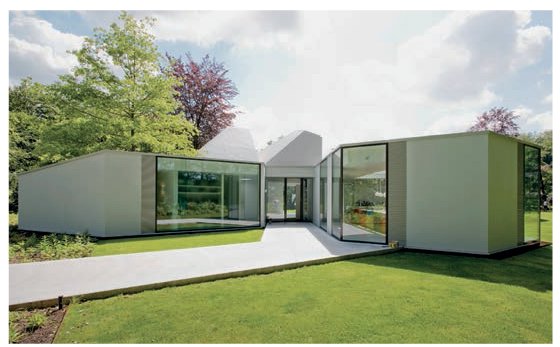
The house underwent several renovations throughout its life cycle.

Rear view with the nearby creek to where the harvester and purified water is released.

Rear entrance showing the new roof addition.
The designers of Villa 4.0 worked to achieve water conservation. Throughout the house, both rain and grey water are collected and treated with an organic purification system, before being released into the nearby creek. Likewise, water is commonly drawn from the creek for various uses around the house. A large accumulation of water in a cistern also acts a cooling agent for the dwelling. In the summer, a rooftop pump draws water, channels it throughout the house and then it flows back into the creek. In addition, without having to leave any windows and doors open, mechanized roof systems in the central hall and a glass sliding roof in the kitchen draw a large quantity of air into the dwelling for cross ventilation.
While the surrounding deciduous trees shade the house in the summer, the architect also equipped the roof with a solar water heater. By using a radiant floor heating system in the newly constructed concrete deck floors, all of the rooms’ temperatures can be regulated independently in winter.
Van Gameren’s design is an example of thoughtful consideration of sustainability in all of its components and represents a practical example of an enjoyable lifestyle that is the least taxing to the environment, in both the short and long term.
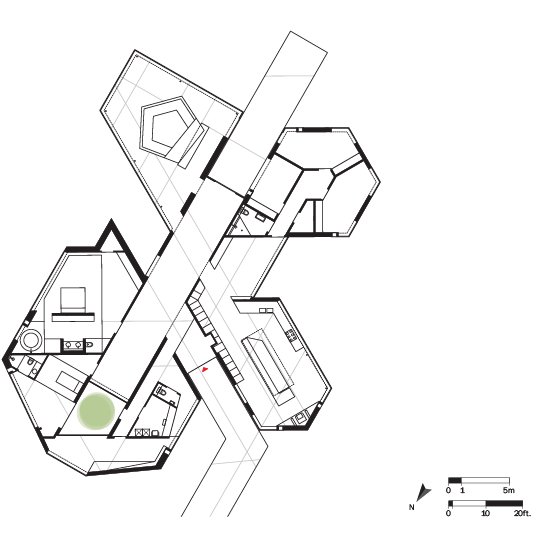
The hexagon-shaped house
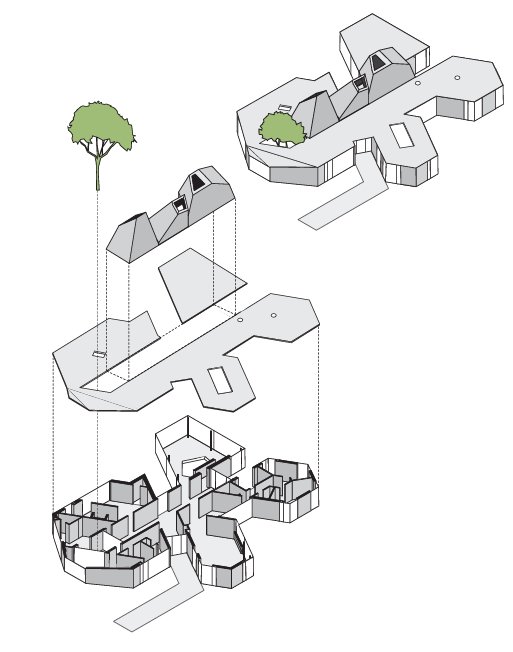
Axonometric view showing the skylights. They also contain solar water heaters.
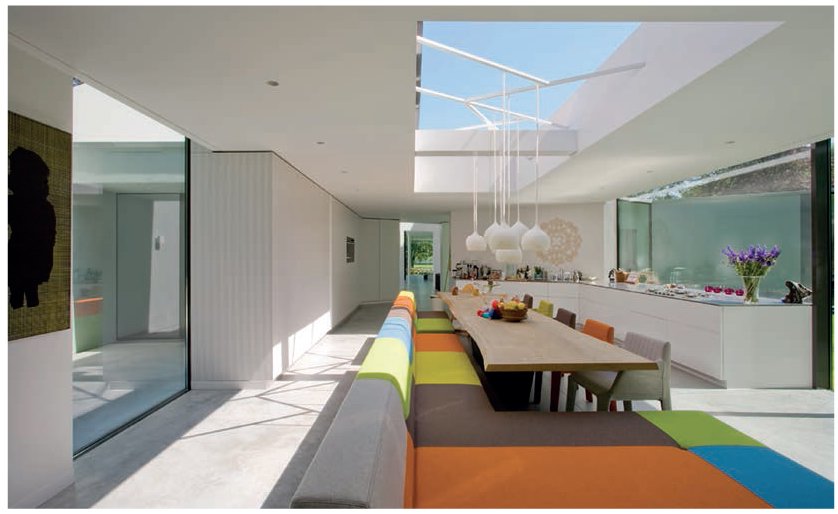
View of the open plan kitchen and dining area.
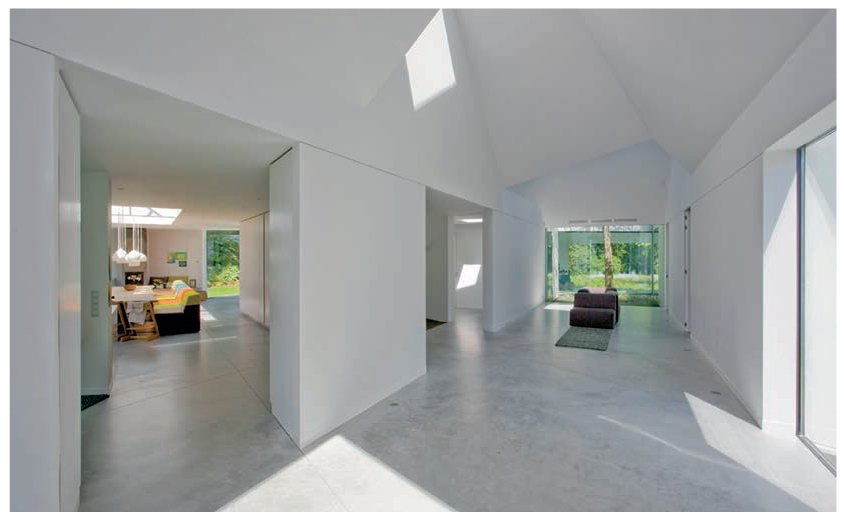
The entrance hallway and the other floors are heated with radiant heating.
16.2 WATER-EFFICIENT DWELLINGS |
|
Project |
7ten |
Location |
Venice, California, USA |
Architect |
GRAYmatter Architecture |
Designers and homeowners in California have always been at the forefront of supporting and promoting houses that are built with sustainability in mind. Located in a popular area of Venice, California, 7ten Project, which measures 359 m2 (3,865 sq ft) in area, is GRAYmatter Architecture’s addition to the small collection of LEED Platinum-certified homes – the highest rating for a ‘green’ house – in the US. In fact, being the first conventionally constructed LEED Platinum home in California, 7ten Project was conceived as an educational model that would create a forum for discussion about environmental awareness.
Inspired by activist Ian McKellen and the film An Inconvenient Truth, developer Tom Schey was determined to build an environmentally conscious home. Indeed, the collaboration between GREYmatter Architecture and environmentalist Kelly Meyer resulted in a house that exemplifies an exquisite, cutting-edge architectural design, while not compromising the environment at all.

Front facade of the 7ten home, where water concentration was a paramount consideration.
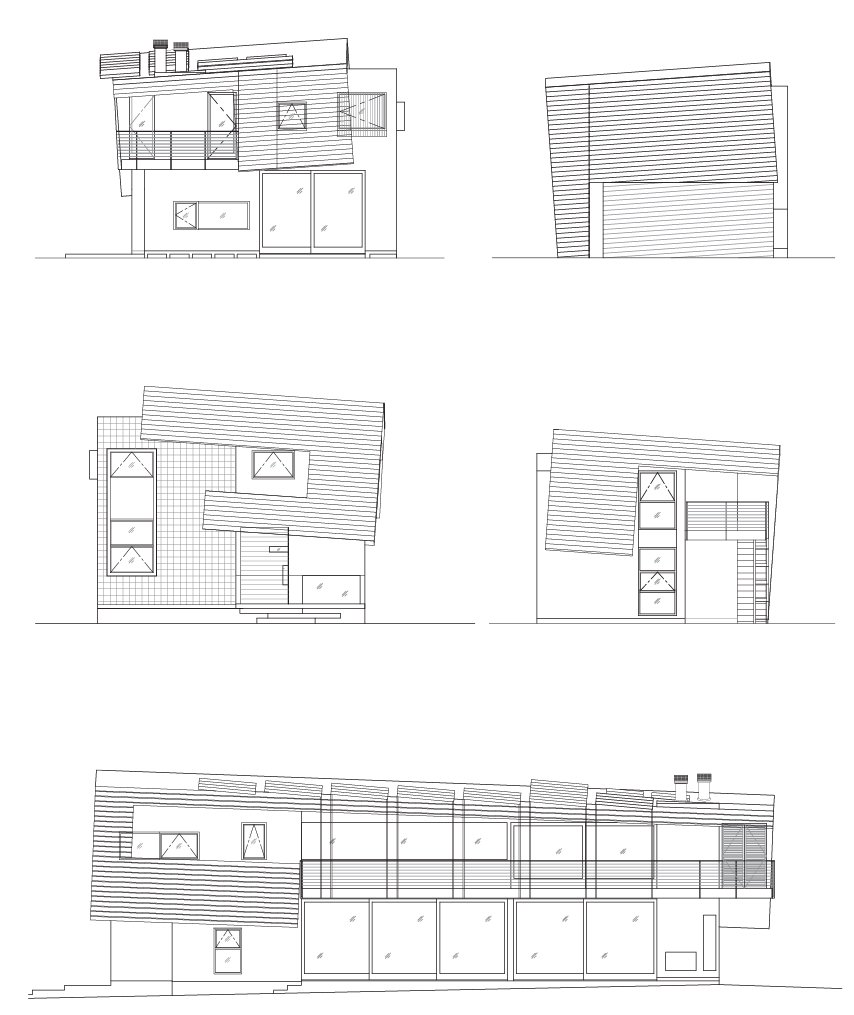
Elevations of the 7ten house. The dwelling earned a LEED Platinum rating.
Every aspect of the house epitomizes the archetype of a ‘green’ design. For example, all the lumber used was FSC-certified, building components were locally sourced and highly sustainable and energy is supplied by solar panels. In addition, the landscaping included native species that require little water and maintenance and caused minimal disturbance to the local ecosystem.
Moreover, a particularly notable aspect of 7ten Project is its incorporation of water-efficient systems. Through effective water management – reusing, reducing and recycling – the architects aimed to make the most of every drop of water in the house. Realizing that one of the most cost-effective sources of water is rain, they integrated a rainwater harvesting system to collect and store run-off rainwater from rooftops and other impermeable surfaces. This collection becomes an on-site water supply for various water uses around the house, such as irrigating the garden and washing cars. In addition, the house also includes a grey water recycling system, which reuses indoor wash water from sinks, baths and dishwashers, for other uses such as toilet flushing. These systems effectively increase the water efficiency of the house by reducing the use of potable water for non-consumption purposes. Furthermore, other key green features of 7ten Project include Energy Star endorsed appliances that guarantee a certain degree of water efficiency. Such features work collaboratively to minimize indoor water use and achieve maximum water efficiency.
With its thoughtful and innovative design, 7ten Project demonstrates that embracing an environmentally conscious lifestyle can be simple, effective and stylish. The house was featured in the Enlightened Development exhibition, presented by the Architecture and Design Museum of Los Angeles, as a showcase of important environmental ventures and the cutting-edge development achieved by architects. 7ten Project realized Schey’s objective of promoting environmentally conscious choices in everyday lives.
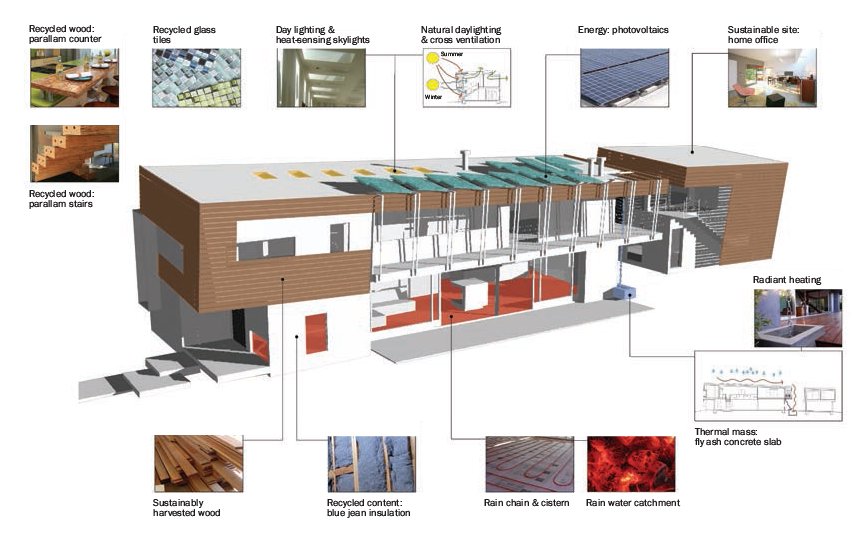
Every aspect of the house conception and construction included ëgreen’ features.
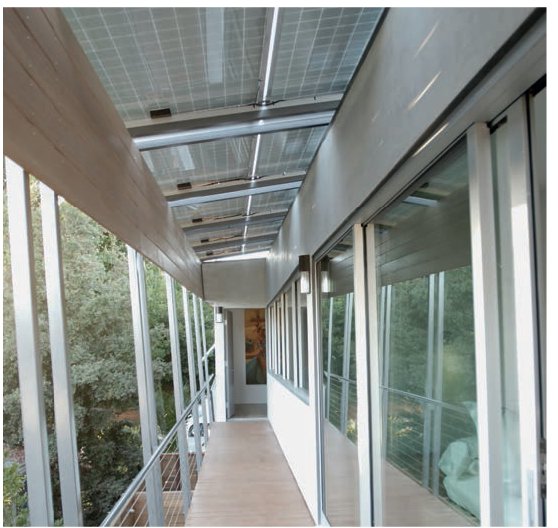
The upper passageway.
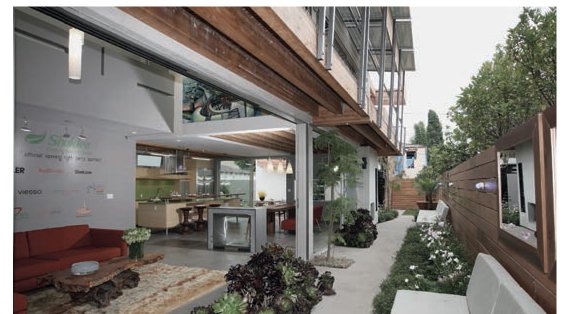
The dwelling’s building components were locally sourced.
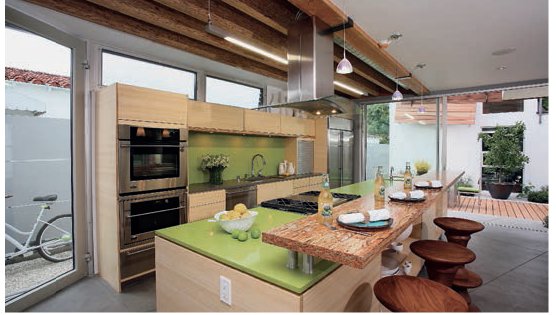
Every aspect of the house conception and construction included 'green' features.
